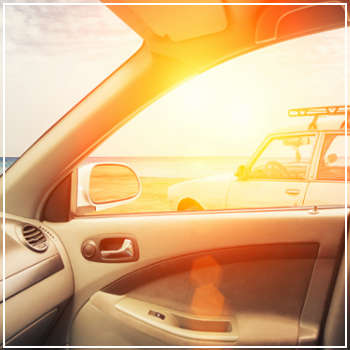When areas inside your car are exposed directly to sunlight, the temperature can rise dramatically, reaching anywhere from 145 to 195 degrees Fahrenheit. Over time, you’ll begin to notice cracks and discoloration creeping into places like the dashboard, upholstery, paint, and other hidden components. Your car's dashboard, being right beneath the windshield, is particularly vulnerable to UV damage. Regular exposure can cause it to lose its original color and develop unsightly cracks. Not only does this ruin the aesthetic appeal, but it could also compromise the structural integrity of the dashboard. The type of material used for your car's upholstery plays a big role in how much it gets damaged by UV rays. Leather seats, while luxurious, can become dry and brittle if left unprotected under the sun. This loss of natural oils leads to a rough texture that’s far from comfortable. To keep leather seats looking their best, make sure to condition them frequently and invest in some good quality seat covers to shield them from UV rays. Even fabrics aren’t immune; they too can fade noticeably after prolonged exposure to sunlight. Direct sunlight isn’t kind to your car’s paint either. Dark-colored vehicles tend to show signs of fading more quickly because of oxidation. Besides changing colors, the UV rays can also harm plastic parts such as bumpers, headlights, and mirrors. These components don’t just lose their vibrant hues but might also form cracks as they age. High temperatures caused by UV exposure can affect more than just the appearance of your car—they can impact its functionality too. Belts and hoses may weaken and break down, leading to potential mechanical failures. Fluids like oil, transmission fluid, and antifreeze can evaporate faster than usual, making it harder for them to do their jobs effectively. This could lead to overheating issues or premature wear and tear on critical parts. Additionally, tires can become overinflated, increasing the risk of blowouts. One simple way to minimize UV damage is to park your car in a garage or use a portable shade whenever possible. This keeps your car cooler overall and reduces the intensity of UV rays hitting its surfaces. Regular cleaning is another key step—wash away any dirt or contaminants like bird droppings before they bake onto your car’s exterior. Afterward, dry it thoroughly with a microfiber cloth to eliminate any lingering mineral deposits that could harm the paintwork. Applying wax helps protect against dirt accumulation while minimizing fading and rust formation. For those times when parking in the shade isn’t feasible, consider using reflective windshield shades to cut down on the amount of UV light penetrating the cabin. Cracking your windows just a bit allows trapped heat to escape, preventing excessive warming inside. If your car has leather interiors, adding seat covers provides extra protection against UV degradation. Have you already spotted some of these warning signs on your own vehicle? DaSilva’s Auto Body offers comprehensive services including interior and exterior detailing, repainting, part replacements, and repairs. Give us a call at our Naugatuck location to schedule an appointment today! Remember, taking proactive measures now can save you significant hassle—and money—down the road. Don’t wait until small problems escalate into major ones requiring costly fixes. Start protecting your investment today! Bubble Mailer Bags,Envelope Mailers,Bubble Mailers,Bubble Envelopes Mailers Dongguan Pasike Packaging Co., Ltd. , https://www.dgpasike.com Even though ultraviolet (UV) light exposure doesn’t always show immediate results, except maybe a painful sunburn, your car could still be silently suffering over time. When parked under the sun for extended periods, both the interior and exterior of your vehicle can slowly degrade due to the combination of UV rays and high temperatures.
Even though ultraviolet (UV) light exposure doesn’t always show immediate results, except maybe a painful sunburn, your car could still be silently suffering over time. When parked under the sun for extended periods, both the interior and exterior of your vehicle can slowly degrade due to the combination of UV rays and high temperatures.Dashboard
Upholstery
Paint Job
Interior Components
How to Protect Your Car